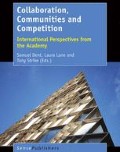Abstract
Many complex problems demand innovative approaches that combine knowledge from different scientific disciplines (Institute of Medicine, National Academy of Sciences, and National Academy of Engineering, 2005; Frodeman et al, 2010). Cross-disciplinary research is therefore gaining importance as an intellectual partnership of demarcated domains of specialised inquiry. In order to prepare future generations of scientists to solve complex problems between and beyond the boundaries of single disciplines, efforts are being made to transform doctoral education.
Access this chapter
Tax calculation will be finalised at checkout
Purchases are for personal use only
Preview
Unable to display preview. Download preview PDF.
References
Bammer, G. (2012). Strengthening interdisciplinary research: What it is, what it does, how it does it and how it is supported. The Australian Council of Learned Academies.
Borrego, M., & Newswander, L. (2008). Characteristics of successful cross-disciplinary engineering education collaboration. Journal of Engineering Education, 97, 123–134. doi:10.1002/j.2168-9830.2008.tb00962.x
Bruce, A., Lyall, C., Tait, J., & Williams, R. (2004). Interdisciplinary integration in Europe: The case of the Fifth Framework programme. Futures, 36(4), 457–470. doi:10.1016/j.futures.2003.10.003
Calatrava Moreno, M. C., & Danowitz, M. A. (2016). Becoming an interdisciplinary scientist: An analysis of students’ experiences in three computer science doctoral programs. Journal of Higher Education Policy and Management, 38(4), 448–464.
Calatrava Moreno, M. C., Auzinger, T., & Werthner, H. (2016). On the uncertainty of interdisciplinarity measurements due to incomplete bibliographic data. Scientometrics, 107(1), 213–232.
Choi, B. C., & Pak, A. W. (2007). Multidisciplinarity, interdisciplinarity, and transdisciplinarity in health research, services, education and policy: 2. Promotors, barriers, and strategies of enhancement. Clinical and Investigative Medicine, 30(6), E224-32.
Domik, G., & Fischer, G. (2011). Coping with complex real-world problems: Strategies for developing the competency of transdisciplinary collaboration. In N. Reynolds, & M. Turcsányi-Szabó (Eds.), Key competencies in the knowledge society (pp. 90–101). New York, USA: Springer.
Frodeman, R., Klein, J. T., & Mitcham, C. (Eds.). (2010). The Oxford handbook of interdisciplinarity. Oxford, UK: Oxford University Press.
Gleed, A., & Marchant, D. (2016). Interdisciplinarity: Survey report for the Global Research Council 2016 annual meeting. Stockport, UK: djs research.
Golde, C. M., & Gallagher, H. A. (1999). The challenges of conducting interdisciplinary research in traditional doctoral programs. Ecosystems, 281–285.
Graybill, J. K., & Shandas, V. (2010). Doctoral student and early career academic perspectives. In R. Frodeman, J. T. Klein, & C. Mitcham (Eds.), The Oxford handbook of interdisciplinarity (pp. 404–418). Oxford, UK: Oxford University Press.
Graybill, J. K., Dooling, S., Shandas, V., Witney, J., Greve, A., & Simon, G. L. (2006). A rough guide to interdisciplinarity: Graduate student perspectives. BioScience, 56(9), 757–763. doi:10.1641/0006-3568(2006)56[757:ARGTIG]2.0.CO;2
Huutoniemi, K., Klein, J. T., Brunn, H., & Hukkinen, J. (2010). Analysing interdisciplinarity: Typology and indicators. Research Policy, 39, 79–88.
Institute of Medicine, National Academy of Sciences, and National Academy of Engineering. (2005). Facilitating interdisciplinary research. Washington, USA: The National Academies Press. doi:10.17226/11153
Jahn, T., Bergmann, M., & Keil, F. (2012). Transdisciplinarity: Between mainstreaming and marginalisation. Ecological Economics, 79, 1–10. doi:10.1016/j.ecolecon.2012.04.017
Klein, J. T. (1990). Interdisciplinarity: History, theory and practice. Detroit, USA: Wayne State University Press.
Lyall, C., Bruce, A., & Marsden, W. (2011). Identifying key sucess factors in the quest for interdisciplinary knowledge.
Palmer, C. L. (2010). Information research on interdisciplinarity. In R. Frodeman, J. T. Klein, & C. Mitcham (Eds.), The Oxford handbook of interdisciplinarity (pp. 174–188). Oxford, UK: Oxford University Press.
Porter, A. L., & Rafols, I. (2009). Is science becoming more interdisciplinary? Measuring and mapping six research fields over time. Scientometrics, 81(3), 719–745.
Qin, J., Lancaster, F. W., & Allen, B. (1997). Types and levels of collaboration in interdisciplinary research in the sciences. Journal of the American Society for Information Science, 48(10), 893–916. doi:10.1002/(SICI)1097-4571(199710)48:10<893::AID-ASI5>3.0.CO;2-X
Sá, C. M. (2008). ‘Interdisciplinary strategies’ in U.S. research universities. Higher Education, 55(5), 537–552. doi:10.1007/s10734-007-9073-5
Scaif, M., Curtis, E., & Hill, C. (1994). Interdisciplinary collaboration: A case study of software development for fashion designers. Interacting with Computers, 6, 395–410.
Scholle, D. (1995). Resisting disciplines: repositioning media studies in the university. Communication Theory, 5, 130–143.
Stirling, A. (2007). A general framework for analysing diversity in science, technology and society. Journal of The Royal Society Interface, 4, 707–719.
van Rijnsoever, F. J., & Hessels, L. K. (2011). Factors associated with disciplinary and interdisciplinary research collaboration. Research Policy, 40(3), 463–472. doi:10.1016/j.respol.2010.11.001
Author information
Authors and Affiliations
Editor information
Editors and Affiliations
Rights and permissions
Copyright information
© 2017 Sense Publishers
About this chapter
Cite this chapter
Moreno, M.D.C.C., Danowitz, M.A. (2017). Insights into Phd Cross-Disciplinary Collaboration, Partnership and Competition in Computer Science. In: Dent, S., Lane, L., Strike, T. (eds) Collaboration, Communities and Competition. SensePublishers, Rotterdam. https://doi.org/10.1007/978-94-6351-122-3_11
Download citation
DOI: https://doi.org/10.1007/978-94-6351-122-3_11
Publisher Name: SensePublishers, Rotterdam
Online ISBN: 978-94-6351-122-3
eBook Packages: EducationEducation (R0)

